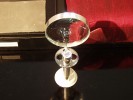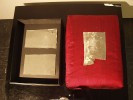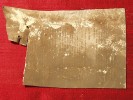The Triumph of Romanticism, 2005
The Triumph of Romanticism
A sculptural meditation on the physical nature of books and printing in the contemporary electronic era, composed of fragments of printing plates, document box, pillow, table, flashlight, magnifying glass, and statement. The project description or statement, a part of the artwork itself, is intended to be displayed along with the other elements. It comments both on romanticism generally, and specifically on the very notion of “text” and the idea of “books” in our current digital era. It contains within it a story of the artist in his garret, creating the work as he “begins feverishly to cut the pages one by one…”
24″x36″x36″ at Maxwell Fine Art, Peekskill, New York
Â
Project Description:
“The Triumph of Romanticism” consists of an archival quality lined leather bound document box, a rectangular Indian red silk display pillow of exactly the same dimensions as the box, a chrome and ceramic stand holding a silver flashlight and magnifying glass, a low square traditional oriental table on which all the elements reside, and 58 fragments of hydrophilic offset lithography plates originally used in the printing of an old literary survey book containing a chapter entitled “Triumph of Romanticism.”
The plates were discovered during demo of a 2000 square foot loft in Williamsburg Brooklyn that was being rehabbed. The plates had been used as a building material, forming the ceiling area around a large skylight.
The story seems hardly plausible, but it is entirely true. Picture if you will, the artist in his garret. There is no heat, not even a radiator. There is no electricity. Water is pouring in from around the edges of the skylight above. A shaft of cold winter light bathes the room. In a desperate attempt to discover the source and staunch the flood, and working from instinct rather than reason, the artist begins ripping away the ceiling around the skylight.
Suddenly a discovery is made, on the reverse side of the dingy white metal ceiling flashing is the text of a work. The very ceiling itself – is a book! In his ecstatic and frenzied state, the Sturm und Drang of the artists dreary existence is forgotten. Seizing a pair of tin snips, and drenched in the icy water pouring down around him, the artist begins feverishly to cut the pages one by one from the ceiling.
For the printed work, offset lithography long ago replaced typesetting as the favored method for making books. Today this method itself is being replaced by print-on-demand from ink jet printers, reading on line, and ebooks. Unlike letterpress, offset printing does not involve raised or etched surfaces. Rather, metal plates are chemically treated to retain water in areas that are to be blank space, and reject water but attract grease or oily ink in areas of text. The plates pass the ink to a rubber surface where it is temporarily offset in reverse, and then to the paper. The result not only involves very little wear and thus allows for large print runs, but it also coincidentally means that the shiny text on the surface of the plates is not reversed and thus perfectly legible, just as regular pages in a book.
“The Triumph of Romanticism” evokes both the 19th century love of archiving, and the impression of a lost antiquity displayed in a cabinet of curiosities. The book preserved as ancient or exotic artifact.
This depiction is reenforced by the changes in society relating to text. It is not uncommon for people these days to consider digital text (where the computer understands each character as individually editable) as “actual” text and printed pages as a kind of archaic picture or snapshot, and not the thing itself. The printed page as dumb object, both annoying and of little use. A kind of ghost or residue of the actual text.
Yet this stupid physical object text may soon be all we have left to preserve text with. A host of systems for Digital Rights Management or DRM are being trotted out by corporations attempting to put a strangle hold on the free flow of information caused by the invention of the internet. The argument they make is they are simply trying to protect the copyright so that people can receive just compensation, but the threat to our freedom to read, teach, and preserve books is so great that the American Library Association, in its Office for Information Technology Policy Brief “Digital Rights Management: A Guide for Librarians” outlines at least six key areas of concern where DRM could fundamentally harm the preservation of cultural knowledge for the future. This is because it involves encoding the digital information in such a way that even though you may be in possession of the digital book,the DRM controller decides what and how you can and can not read.
Yet writing is by nature an encoding, and thus always requires some device to decode it – whether a computer program, or simply vision, speech, and language. Cory Doctorow in his brilliant and impressive critique of DRM from the June 17, 2004, “Microsoft Research DRM talk” says “Paper books are the packaging that books come in.” Though he makes light of “how nice a book looks on your bookcase and how nice it smells” and seems almost dismissive of paper books as trash, this statement regarding books and packaging contains a vital notion. The book is the ideas encoded in the text, no matter what form the text is delivered in.
And so we finally circle back around to the book in the ceiling and the artwork made from it. In the electronic text age, here is the supposed “Triumph of Romanticism” – some loose fragments of metal left over from the dark ages of printing. Clearly there is no triumph. This does not constitute the effective preservation of 19th century literature, nor does it solve the problem of how to preserve books, in general, in the face of the overwhelming corporate and national control of media in the coming generation of the electronic age.
In the “The Triumph of Romanticism” the two forgotten art forms of books and found art come together in some kind of pale continued existence. The display, stuck in a maudlin reverence and elegiac longing for the past, strives mightily to achieve its goal, and fails. Yet what is this but a kind of reencoding and presentation of a lost set of ideals – the very essence of romanticism?







